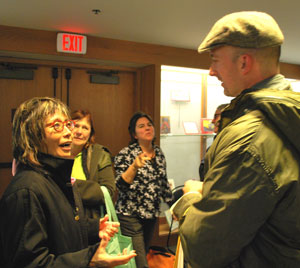Garden Me, But Where’s the Front Lawn?

Frizt Haeg presents his "Edible Estates" project to a gathering at the downtown Ann Arbor District Library.
In Fritz Haeg’s first slide, shot straight down into his own compost pile, a banana peel was still discernible. “This,” he said, “was what we should be celebrating!” Not banana peels per se, but rather compost – a kind of recycling that does not lose value with each cycle as many of our other efforts do (like, for example, paper recycling).
Haeg was standing in front of about 40 people in the multipurpose room of the Ann Arbor District Library to present his project, “Edible Estates,” which involves installations of gardens in place of front lawns. He’s implemented gardens as front lawn replacements in various locations across the U.S., and has done one in England. Haeg first traced the history of the lawn from a demonstration of wealth in the English estate, to the definition of a unfenced democratic space given privilege at Jefferson’s Monticello, to a hostile no-man’s land in post-war suburban development.
Haeg then showed some before-and-after shots of lawns that had been converted to gardens. This kind of documentation is a part of his work of art, which is distributed across the world. Not every lawn is a good candidate for an “Edible Estates” installation. Aside from the need that the work be commissioned by a fiduciary like a museum, Haeg said the ideal lawn is one that is smack in the middle of a street otherwise lined with perfect patches of green lawn. And the ideal homeowner for an “Edible Estates” installation is someone who is interested in sharing the story of the garden as it evolves after installation – it becomes their garden, because Haeg lays no further claim to it.

Michael Appel, executive director of Avalon Housing, which hosted Haeg's talk, makes the introduction.
Haeg clearly knew where he was speaking, acknowledging that while in other locales, a front-lawn replacement might well generate outrage and protest, or at least loud grumbling, he imagined that here in Ann Arbor it might well be met with a round of applause. Indeed, when he did a quick poll of the audience to determine how many people were growing food around their own homes now, he concluded that he was “preaching to the converted.”
One of those converted was Ellen, who lives at Carrot Way and who related how she gardened her front lawn, using dirt from a nearby Project Grow garden, edging it with bricks bought for 10-cents apiece from Habitat for Humanity’s ReStore. Ellen enjoyed a nice crop of strawberries this year.
Haeg’s appearance was hosted by Avalon Housing. In the course of his introduction of Haeg, Avalon’s executive director Michael Appel described the nonprofit he directs as committed to providing quality housing to those with the fewest options. What’s the connection to gardening? As Paula Baldoni, director of communications for Avalon, explained to The Chronicle, Avalon has gardening programs at some of its housing sites, and is looking to expand that program. When she saw a feature on Haeg in the shelter magazine “Dwell,” she thought it would be a good fit.

Lori Saginaw, Paula Baldoni (pointing in background) and Fritz Haeg share a light moment after Haeg's talk.
Convincing Haeg to come speak wasn’t a matter of leveraging some n-th degree personal connection – it was as straightforward as sending an email.
The book “Edible Estates: Attack on the Front Lawn” was available for purchase after Haeg’s talk, and is available online as well.
Next up for Haeg is a project that involves converting homeowners’ garages into retail space, one that poses some more challenging hurdles with respect to zoning than the front lawn conversion project.




This book is available for checkout at the Ann Arbor District Library:
http://www.aadl.org/cat/seek/record=1307772
14 holds on first copy returned of 5 copies.